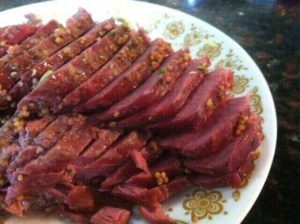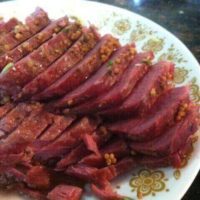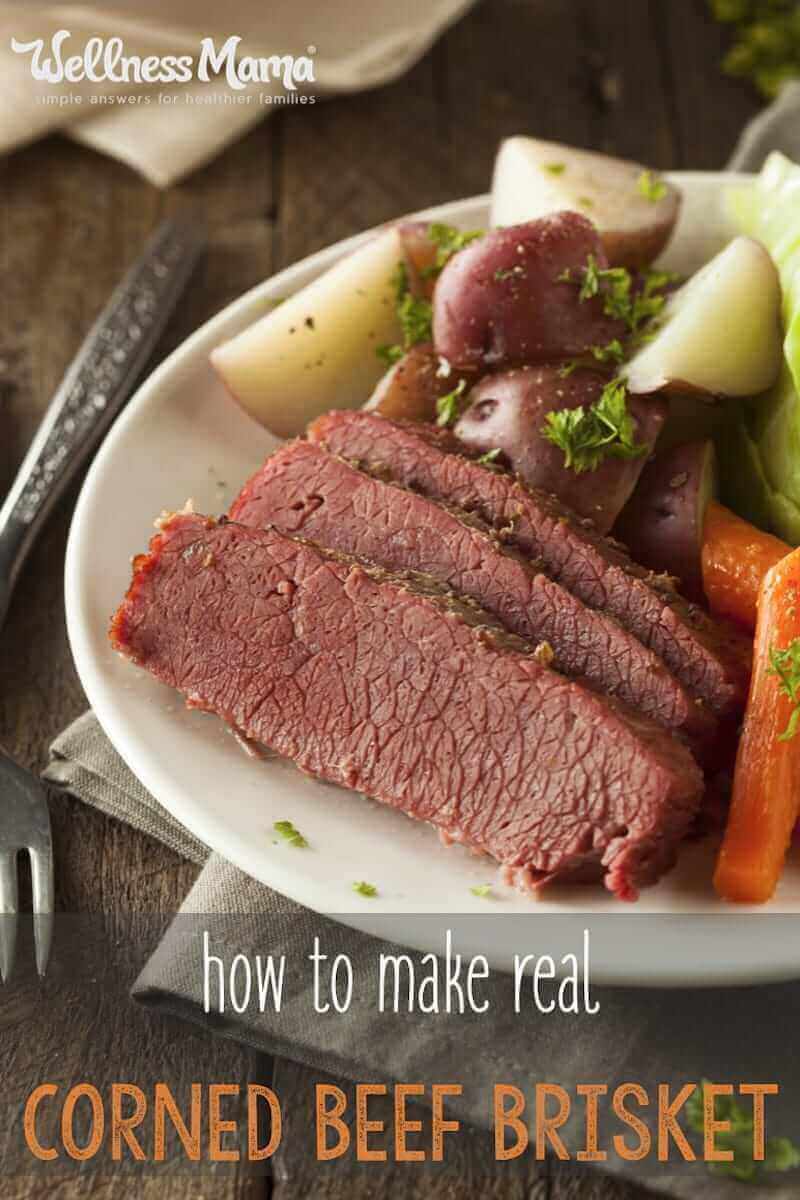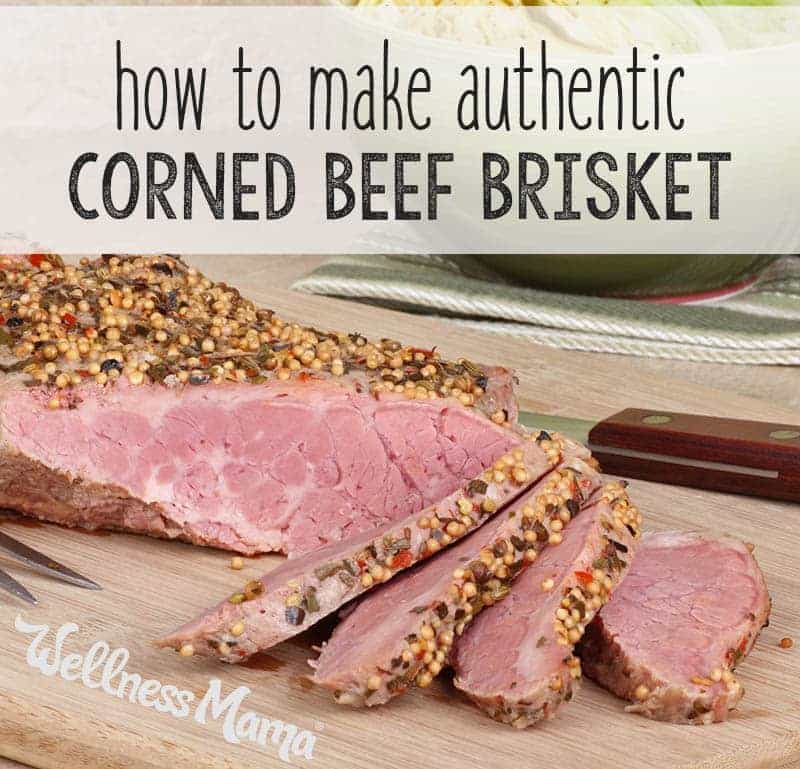I’m an Irish girl (though married to an Italian), and corned beef brisket has been a St. Patrick’s Day tradition for us for years. The week before St. Patty’s the menu plan always features shamrock shakes (the not from McDonalds kind), bangers and mash, and other traditional Irish meals.
Ironically, the Irish don’t even have a tradition of making corned beef on St. Patty’s Day as we do in America… or of green beer or cheerful leprechauns for that matter.
So why the popular dish? Read on!
Corned Beef Brisket: A Wee Bit O’ History

Corned beef brisket wasn’t native to Ireland originally, but came about when the British came to rule. The British married their love of beef to Ireland’s plentiful salt (which tended to be a large, corn kernel size salt, hence the name “corned”) to produce “corned beef.”
Ironically, the Irish seldom ate corned beef themselves as it was too expensive. It was actually Irish-American immigrants who adopted the dish from their Jewish kosher butcher neighbors and started serving it in honor of St. Patrick’s Day, along with the very Irish potatoes and cabbage now traditionally served with the dish.
We’re happy to carry on this delicious tradition at our house and take our corned beef seriously. There’s one important step that makes all the difference: a homemade brisket brine.
Brining Your Own Corned Beef
Why brine your own brisket instead of buying prepared corned beef?
It’s easy enough to find a corned beef brisket in just about any grocery store before St. Patrick’s Day, pre-made and neatly packaged in its plastic bag and very … artificially pink. They use saltpeter to accomplish this (chemically known as potassium nitrate) which is also used to make fireworks and gunpowder, and even dissolve tree stumps.
I don’t like the sound of that kind of thing in my food, so I’ve started making my own corned beef from beef brisket instead. It’s an inexpensive cut of meat, really easy to make, and has a much better flavor than store-bought anyway.
The only thing it won’t have is that hot pink color that the store-bought versions have. To compensate, I add beet juice and hot pink sauerkraut to the last part of the brining process, and … voilà! Hot pink corned beef.
How to Make Real Corned Beef Brisket
I adapted this brining recipe from Alton Brown’s version. I love his shows (even though I won’t cook many of the things he does), but he explains the chemistry of cooking so well. (Yes, I’m a dork, I know.)
Homemade corned beef brisket does take a little meal planning ahead of time, but I promise the result is so worth it! Alton’s version lists the prep time as 243 hours (!), but my version takes 3-5 days at most. Of course almost all of that prep time requires no work at all. Just let the brisket sit in the fridge and absorb all the (healthy) yumminess.
Step 1: Buy Beef Brisket and Spices (A Week Before You Need It)
Buy from a trusted farmer or quality butcher if you can. I don’t have either in my area so I keep meats from ButcherBox stashed in my deep freezer. If I buy one from the store, I skip the cuts labeled “corned beef” and buy a plain brisket with no additives instead.
Note that this recipe calls for either beet juice or purple cabbage sauerkraut to get the pink color corned beef is known for. If you make sauerkraut or have been wanting to try, start it well ahead of St. Patrick’s Day following this recipe.
Step 2: Assemble Spices
Don’t let the number of spices intimidate you; several of them are optional if you don’t have them around.
Step 3: Brine 3 to 5 Days Ahead of Time
Let your brisket take a bath in the pickling liquid for 3-5 days before St. Patrick’s Day (or any time you want corned beef)!
On St. Patrick’s Day: Make Corned Beef and Cabbage!
Take corned brisket out of the bath, discard brine, and put meat into slow cooker or Instant Pot. Cook according to directions for tender, falling apart corned beef, add veggies, and enjoy the result… a much healthier St. Patty’s Day celebration!

Corned Beef Brisket Recipe (Brine Your Own)
Servings
Ingredients
- 4-5 lb beef brisket
For the brine:
- 2 qt water
- 1 cup sea salt
- ½ cup cane sugar (or brown sugar)
- 1 cinnamon stick (or ¼ tsp cinnamon powder)
- 1 TBSP mustard seeds
- 1-2 TBSP black peppercorns
- 8-10 whole cloves
- ½ tsp ginger powder (or 1 tsp fresh ginger, minced)
- ½ tsp thyme
- 5 cloves garlic (crushed, or ½ tsp garlic powder)
- 2-3 bay leaf (crushed)
- 1 tsp allspice berries (optional)
- 1 TBSP coriander seeds (optional)
- 1 tsp juniper berries (optional)
- ¼ cup beet juice (or juice from homemade sauerkraut made with purple cabbage, optional – it's just for color)
Instructions
- Make the brine by putting the water, salt, sugar, and spices (except beet juice or sauerkraut juice) in a large pot and heating, stirring frequently, until sugar and salt dissolve. Cool liquid, using 2 cups of ice if needed, and place in refrigerator until very cold. It is very important that the brine is cold before it comes in contact with the meat.
- For the 3-5 day brining process, you can either place the brisket in a large 2-gallon bag and add the brine, or place the brisket in a large glass container with a lid and add the brine. Either way, you want the brisket to be completely submerged and surrounded with the brine. Add the beet juice or sauerkraut juice (if using) at this point.
- Place in the fridge (if you use the plastic bag put it inside another dish in case it leaks) and leave it there for at least 3 days (5 days if possible). Each day, flip it over and move the brine around.
- After 3-5 days, remove from the brine, rinse well with cool water, and cook as you normally would a corned beef brisket. (Don’t normally cook a corned beef brisket? See this recipe.)
- The end!
Nutrition
Notes
Ever made corned beef? How do you prepare it? Share below!



Leave a Reply